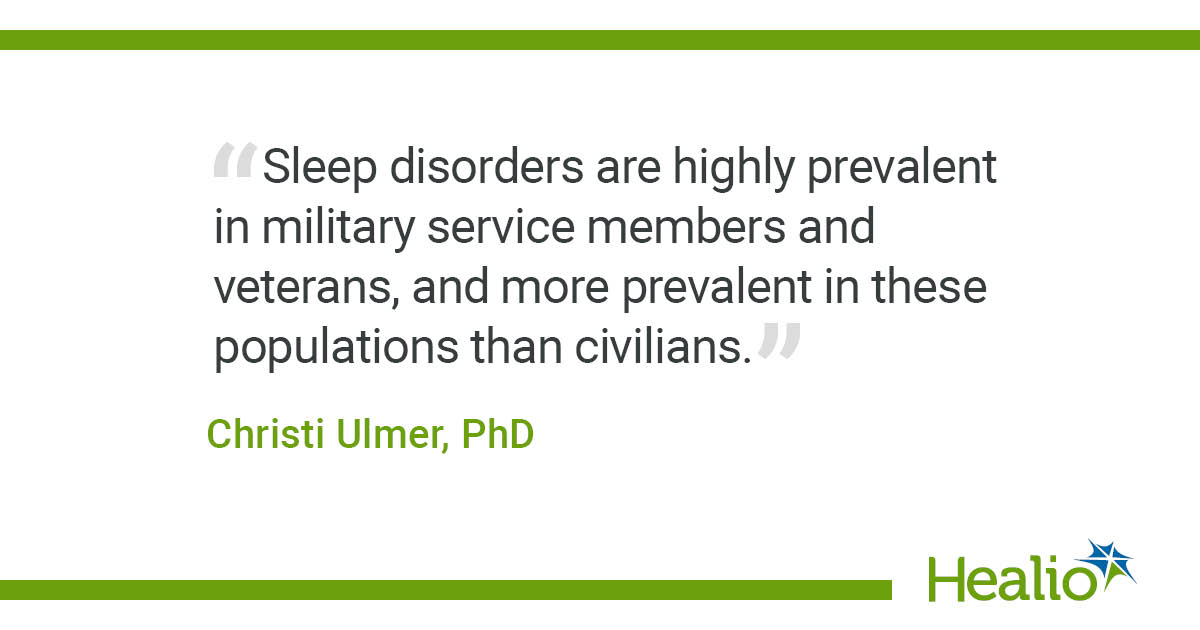VA, DOD release guidelines for insomnia, obstructive sleep apnea
The Veteran’s Association and Department of Defense recently released guidelines for managing insomnia and obstructive sleep apnea among patients in their health care system.
“Sleep disorders are highly prevalent in military service members and veterans, and more prevalent in these populations than civilians,” co-author Christi Ulmer, PhD, an assistant professor in psychiatry and behavioral sciences at Duke University School of Medicine and faculty in the Durham VA Healthcare System Behavioral Medicine Post-Doctoral training program, told Healio Primary Care.
One study found that among surveyed military personnel, 48.6% had poor sleep quality. Another found that the prevalence of insomnia symptoms among service members was 41% in those deployed in combat and 25% among those who did not serve in combat.
“To date, however, health care providers have not been provided with clear guidance on how to address the [two] most prominent sleep disorders, insomnia disorder and obstructive sleep apnea,” Ulmer said. “The VA/DoD Clinical Practice Guidelines were written with frontline providers in mind and offer an evidence-based approach to management of these conditions.”

The recommendations
The two organizations created a panel with four co-chairs and a group of practicing clinicians across multiple specialties, including sleep medicine, neurology, psychiatry, pulmonology, internal medicine and otolaryngology.
They conducted a series of literary reviews to assess the efficacy of multiple treatment approaches for insomnia and sleep apnea.
Based on these reviews, the group recommended positive airway pressure (PAP) therapy to treat OSA for the patient’s entire sleep period. They noted that because adherence to PAP treatment can be a challenge for some patients, they should continue to use it, even if they do so for less than 4 hours per night.
For chronic insomnia disorders, the work group recommended using cognitive behavioral therapy, including sleep restriction therapy, stimulus control, relaxation therapy, counter-arousal strategies and sleep hygiene education.
The work group did not recommend the use of sleep-hygiene education or pharmacotherapy as a first-line therapy despite the fact they are the most common treatments for insomnia. They explained that this was because sleep hygiene education alone was not found to be effective and could end up causing harm to a patient if they subsequently chose not to undergo cognitive behavioral therapy because they believe it is also ineffective.
The group recommended that pharmacotherapy be used only in patients who are unable or unwilling to undergo cognitive behavioral therapy because behavioral interventions were shown to be more effective. However, they recommended a short course of 3 mg or 6 mg of doxepin or nonbenzodiazepine benzodiazepine receptor agonists to certain patients.
They also recommended against the use of benzodiazepines or trazodone for chronic insomnia disorder because of their association with adverse events, including falls, cognitive impairment and hypoventilation.
The group recommended against the herbal remedy kava because of FDA warnings regarding an increased risk for acute liver damage and death associated with the drug. They also recommended against using valerian, chamomile and melatonin because of a lack of evidence to support their efficacy.
Impact of sleep disorders on military personnel
Q. Afifa Shamim-Uzzaman, MD, MS, director of the Ann Arbor VA Sleep Disorders Center and an associate professor in the departments of internal medicine and neurology at the University of Michigan who was not part of the guidelines development, told Healio Primary Care that in addition to studies demonstrating a higher prevalence of OSA and insomnia in military personnel and veterans, study findings have shown that those with sleep disturbances “often also have post-traumatic stress disorder (PTSD), mood disorders such as anxiety/depression and traumatic brain injury (TBI) that can complicate the identification and treatment of these two sleep disorders.”
Shamim-Uzzaman noted that recent work has also suggested that sleep disorders like OSA and insomnia may aggravate symptoms of mood disorders, TBI and PTSD.
“Therefore, early identification and management of OSA and insomnia is important to the overall health of military personnel and veterans,” she said.
Ulmer noted that associations between these sleep conditions and comorbidities — including suicidality among veterans with insomnia as well as stroke and myocardial infarction among adults with OSA — also highlight the need for early identification and management of these conditions in veterans.
Vincent Mysliwiec, MD, professor of research in the department of psychiatry and behavioral sciences at UT Health San Antonio and lead author of the guidelines, told Healio Primary Care that diagnosing and treating these conditions in military personnel and veterans is “essential as it improves not only their sleep but their daytime performance — which can be critical for military personnel who have a high-risk occupation — their overall physical and mental health, as well as the sleep of their bed partners and family.”
He explained that although these guidelines were geared toward veterans and military personnel, they are also applicable to civilians with OSA and insomnia. – by Erin Michael
References:
Mysliwiec V, et al. Ann Intern Med. 2020;doi:10.7326/M19-3575.
Taylor DJ, et al. Sleep. 2016;doi:10.5665/sleep.6156.
Troxel WM, et al. Sleep in the military. https://www.rand.org/content/dam/rand/pubs/research_reports/RR700/RR739/RAND_RR739.pdf. Accessed March 31, 2020.
Disclosures: Mysliwiec reports personal fees from CPAP Medical outside the submitted work. Ulmer reports no relevant financial disclosures.
